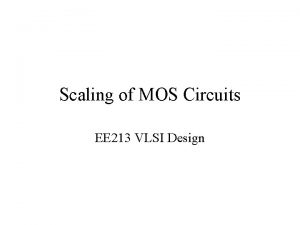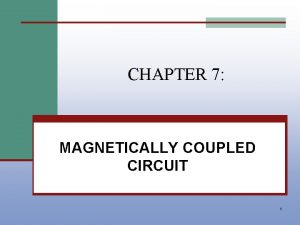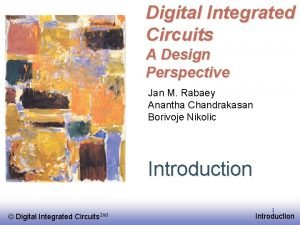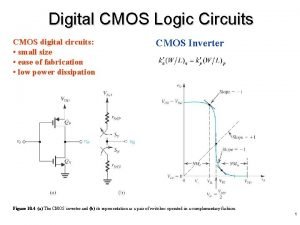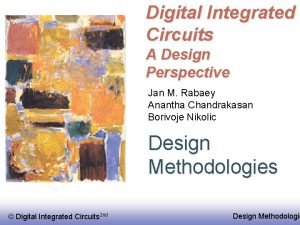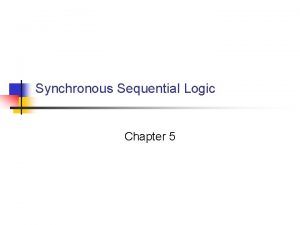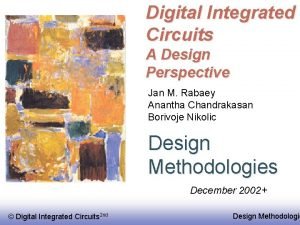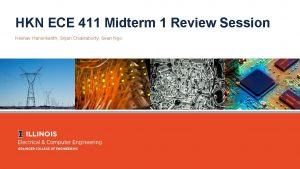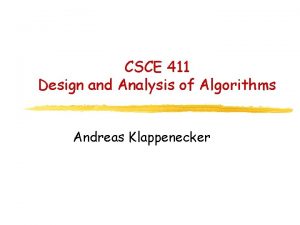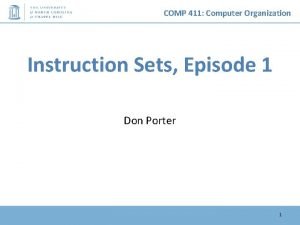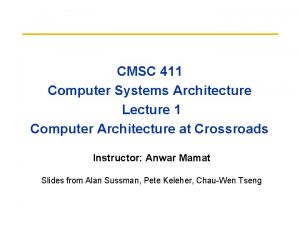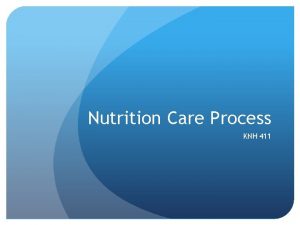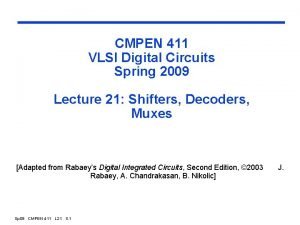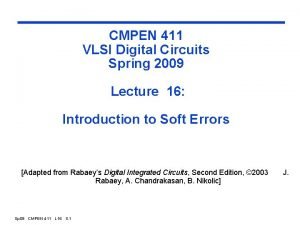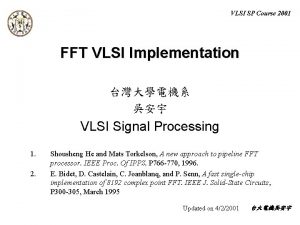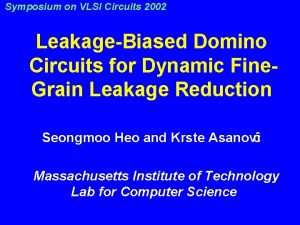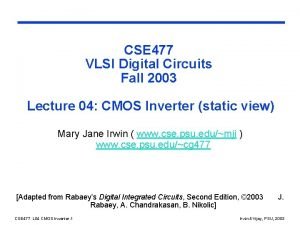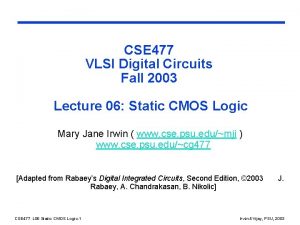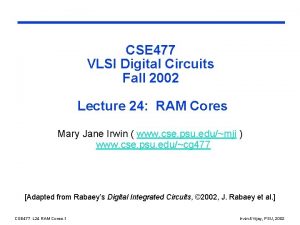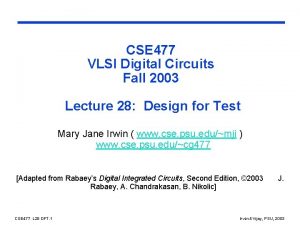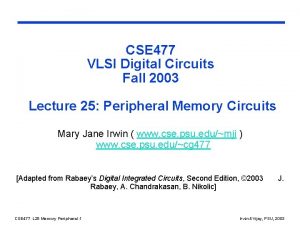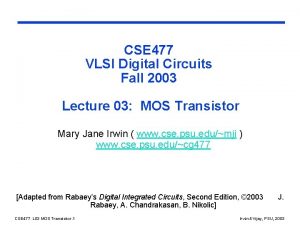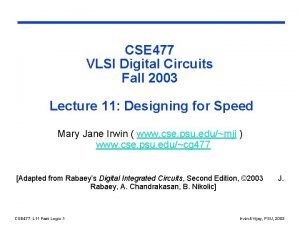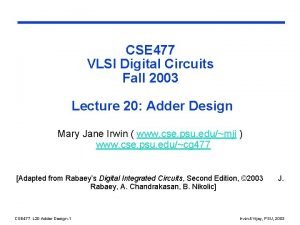CMPEN 411 VLSI Digital Circuits Spring 2009 Lecture























- Slides: 23

CMPEN 411 VLSI Digital Circuits Spring 2009 Lecture 20: Multiplier Design [Adapted from Rabaey’s Digital Integrated Circuits, Second Edition, © 2003 Rabaey, A. Chandrakasan, B. Nikolic] Sp 09 CMPEN 411 L 20 S. 1 J.

Review: Basic Building Blocks q Datapath l Execution units - Adder, multiplier, divider, shifter, etc. q l Register file and pipeline registers l Multiplexers, decoders Control l q Interconnect l q Finite state machines (PLA, ROM, random logic) Switches, arbiters, buses Memory l Caches (SRAMs), TLBs, DRAMs, buffers Sp 09 CMPEN 411 L 20 S. 2

The Binary Multiplication Sp 09 CMPEN 411 L 20 S. 3

Multiply Operation q Multiplication is just a a lot of additions N multiplicand multiplier partial product array N can be formed in parallel double precision product 2 N Sp 09 CMPEN 411 L 20 S. 4

Multiplication Approaches q Right shift and add l Partial product array rows are accumulated from top to bottom on an N-bit adder - After each addition, right shift (by one bit) the accumulated partial product to align it with the next row to add l q Time for N bits Tserial_mult = O(N Tadder) = O(N 2) for a RCA Making it faster l Use a faster adder l Use higher radix (e. g. , base 4) multiplication – O(N/2 Tadder) - Use multiplier recoding to simplify multiple formation (booth) l q Sp 09 Form the partial product array in parallel and add it in parallel Making it smaller (i. e. , slower) l Use serial-parallel mult l Use an array multiplier - Very regular structure with only short wires to nearest neighbor cells. Thus, very simple and efficient layout in VLSI Can be easily and CMPEN 411 L 20 S. 5 efficiently pipelined

Serial-parallel multiplier structure Sp 09 CMPEN 411 L 20 S. 6

The Array Multiplier Sp 09 CMPEN 411 L 20 S. 7

Booth multiplier q Encoding scheme to reduce number of stages in multiplication. q Performs two bits of multiplication at once—requires half the stages. q Each stage is slightly more complex than simple multiplier, but adder/subtracter is almost as small/fast as adder. Sp 09 CMPEN 411 L 20 S. 11

Booth encoding q Two’s-complement form of multiplier: y = -2 nyn + 2 n-1 yn-1 + 2 n-2 yn-2 +. . . (first bit is the sign bit) (example, y=18=010010 y= -18 = 101110 ) l q Rewrite using 2 a = 2 a+1 - 2 a: l q y = 2 n(yn-1 -yn) + 2 n-1(yn-2 -yn-1) + 2 n-2(yn-3 -yn-2) +. . . Consider first two terms: by looking at three bits of y, we can determine whether to add x, 2 x to partial product. Sp 09 CMPEN 411 L 20 S. 12

Booth actions l q y = 2 n(yn-1 -yn) + 2 n-1(yn-2 -yn-1) + 2 n-2(yn-3 -yn-2) +. . . Consider first two terms: by looking at three bits of y, we can determine whether to add x, 2 x to partial product. yi yi-1 yi-2 increment 000 0 001 x 010 x 011 2 x 100 -2 x 101 -x 110 -x 111 0 Sp 09 CMPEN 411 L 20 S. 13

Booth example q x = 1001 (910), y = 0111 (710). q P 0 = 0000 q y 3 y 2 y 1=011 q y 1 y 0 y-1=11(0) = 110, P 1 = P 0 - (1001) = 11110111 q x shift left for 2 bits to be 100100 q y 3 y 2 y 1 = 011, P 2 = P 1 (10*100100) = 11110111+01001000 = 001111111 (6310) q An array multiplier needs N addtions, booth multiplier needs only N/2 additions Sp 09 CMPEN 411 L 20 S. 14

Review: A 64 -bit Adder/Subtractor add/subt q q Ripple Carry Adder (RCA) built out of 64 FAs Subtraction – complement all subtrahend bits (xor gates) and set the low order carry-in RCA l advantage: simple logic, so small (low cost) l disadvantage: slow (O(N) for N bits) and lots of glitching (so lots of energy consumption) Sp 09 CMPEN 411 L 20 S. 15 A 0 1 -bit FA C 1 S 0 A 1 1 -bit FA C 2 S 1 A 2 1 -bit FA C 3 S 2 B 0 B 1 B 2 . . . q C 0=Cin C 63 A 63 B 63 1 -bit FA S 63 C 64=Cout

Booth structure Sp 09 CMPEN 411 L 20 S. 16

Wallace-Tree Multiplier Sp 09 CMPEN 411 L 20 S. 17

Wallace-Tree Multiplier Full adder = (3, 2) compressor Sp 09 CMPEN 411 L 20 S. 18

Making it Faster: Tree Multiplier Structure 0 D Q (‘ier) 0 D 0 D (‘icand) partial product array reduction tree fast carry propagate adder (CPA) Sp 09 CMPEN 411 L 20 S. 19 mux + reduction tree (log N) + CPA (log N) P (product) interconnect multiple forming circuits

(4, 2) Counter q Built out of two (3, 2) counters (just FA’s!) l l all of the inputs (4 external plus one internal) have the same weight (i. e. , are in the same bit position) the internal carry output is fed to the next higher weight position (indicated by the ) (3, 2) Sp 09 CMPEN 411 L 20 S. 20 Note: Two carry outs - one “internal” and one “external”

Tiling (4, 2) Counters q (3, 2) (3, 2) Reduces columns four high to columns only two high l l Tiles with neighboring (4, 2) counters Internal carry in at same “level” (i. e. , bit position weight) as the internal carry out Sp 09 CMPEN 411 L 20 S. 22

4 x 4 Partial Product Array Reduction q Fast 4 x 4 multiplication using (4, 2) counters q How would you lay it out? multiplicand multiplier partial product array reduced pp array (to CPA) double precision product Sp 09 CMPEN 411 L 20 S. 24 five (4, 2) counters 5 -bit CPA 8 -bit product

8 x 8 Partial Product Array Reduction Wallace tree multiplier q ‘icand ‘ier partial product array two rows of nine (4, 2) counters reduced partial product array one row of thirteen (4, 2) counters to a 13 -bit fast CPA Sp 09 CMPEN 411 L 20 S. 25

An 8 x 8 Multiplier Layout q How should it be laid out? multiplicand multiplier nine (4, 2) counters thirteen (4, 2) counters 13 -bit CPA Sp 09 CMPEN 411 L 20 S. 26

Multipliers —Summary Sp 09 CMPEN 411 L 20 S. 32

Next Lecture and Reminders q Next lecture l Shifters, decoders, and multiplexers - Reading assignment – Rabaey, et al, 11. 5 -11. 6 Sp 09 CMPEN 411 L 20 S. 33
 Scaling factors for device parameters in vlsi
Scaling factors for device parameters in vlsi What is a parallel circuit in physics
What is a parallel circuit in physics Cmos vlsi design lecture notes
Cmos vlsi design lecture notes Magnetically coupled circuits lecture notes
Magnetically coupled circuits lecture notes 01:640:244 lecture notes - lecture 15: plat, idah, farad
01:640:244 lecture notes - lecture 15: plat, idah, farad Four seasons korean movie
Four seasons korean movie What are the months of spring?
What are the months of spring? Digital integrated circuits a design perspective
Digital integrated circuits a design perspective Digital integrated circuits: a design perspective
Digital integrated circuits: a design perspective Digital circuits
Digital circuits Troubleshooting digital circuits
Troubleshooting digital circuits Digital integrated circuits a design perspective
Digital integrated circuits a design perspective State diagram of jk flip flop
State diagram of jk flip flop Digital integrated circuits
Digital integrated circuits Integrated circuit
Integrated circuit Characteristics of digital ic
Characteristics of digital ic Nutrition 411
Nutrition 411 Mgt 411
Mgt 411 Ece 411
Ece 411 Csce 411
Csce 411 Comp 411
Comp 411 Cmsc 411
Cmsc 411 Ada 411
Ada 411 Nutritional assessment definition
Nutritional assessment definition
